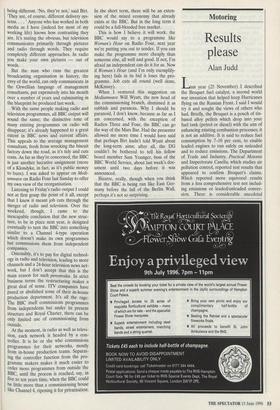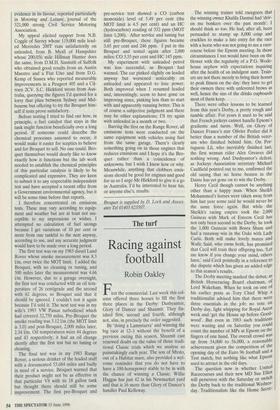Motoring
Results please
Alan Judd
Last year (25 November) I described the Broquet fuel catalyst, a second world war invention that helped keep Hurricanes flying on the Russian Front. I said I would try it and sought the views of others who had. Briefly, the Broquet is a pouch of tin- based alloy pellets which drop into your fuel tank (petrol or diesel) with the aim of enhancing existing combustion processes; it is not an additive. It is said to reduce fuel consumption by 7-10 per cent, to enable leaded engines to run safely on unleaded and to reduce emissions. The Department of Trade and Industry, Practical Motorist and Inspectorate Casella, which studies air pollution control, reported test results that appeared to confirm Broquet's claims. Which reported more equivocal results from a less comprehensive test not includ- ing emissions or leaded/unleaded conver- sion. There is considerable anecdotal evidence in its favour, reported particularly in Motoring and Leisure, journal of the 321,000 strong Civil Service Motoring Association.
My appeal elicited support from N.B. Coggle of Surrey whose 119,000 mile lead- ed Mercedes 200T runs satisfactorily on unleaded, from B. Myall of Hampshire whose 200,056 mile Hillman Hunter does the same, from D.M.H. Sixsmith of Suffolk who obtained good results from an Austin Maestro and a Fiat Uno and from D.G. Kemp of Sussex who reported measurable improvements in a Peugeot 405 and a Cit- roen 2CV. S.C. Hickford wrote from Aus- tralia, querying the figures I'd quoted for a lorry that plies between Sydney and Mel- bourne but offering to try the Broquet him- self if tests prove satisfactory.
Before testing I tried to find out how, in principle, a fuel catalyst that stays in the tank might function beneficially over a long period. If someone could describe the chemical processes assumed to occur, it would make it easier for sceptics to believe and for Broquet to sell. No one could. Bro- quet themselves would dearly like to know exactly how it functions but the lab work needed to establish the chemical principles of this particular catalysis is likely to be complicated and expensive. They are keen to submit it to any respectable independent test and have accepted a recent offer from a Government environmental agency, but it will be some time before that reports.
I therefore concentrated on emissions tests. These may vary according to equip- ment and weather but are at least not sus- ceptible to my impressions or wishes. I attempted no calculation of fuel savings because I get variations of 10 per cent or more from one tankful to the next anyway, according to use, and any accurate judgment would have to be made over a long period.
The first test was on my 1983 diesel Land Rover whose smoke measurement was 8.3 1/m, over twice the MOT limit. I added the Broquet, with no cleaning or tuning, and 500 miles later the measurement was 4.66 l/m. However, due to a garage oversight, the first test was conducted with an oil tem- perature of 26 centigrade and the second with 62 degrees, so Broquet said that it should be ignored. I couldn't test it again because I'd sold it. The next test was in my wife's 1993 VW Passat turbodiesel which had covered 32,750 miles. Pre-Broquet the smoke reading was 3.12 l/m (the MOT limit is 3.0) and post-Broquet, 2,000 miles later, 2.34 l/m. Oil temperatures were 44 degrees and 43 respectively; it had an oil change shortly after the first test but no tuning or cleaning.
The final test was in my 1983 Range Rover, a serious drinker of the leaded stuff with a documented 53,684 miles and badly in need of a service. Broquet warned that their product might not be as effective in that particular V8 with its 18 gallon tank but thought there should still be some improvement. The first pre-Broquet and pre-service test showed a CO (carbon monoxide) level of 5.49 per cent (the MOT limit is 4.5 per cent) and an HC (hydrocarbon) reading of 332 ppm (MOT limit 1,200). After service and tuning but still pre-Broquet, these figures became 3.65 per cent and 246 ppm. I put in the Broquet and tested again after 2,000 miles: CO 3.55 per cent and HC 145 ppm.
My experiment with unleaded petrol was less successful, as Broquet had warned. The car pinked slightly on leaded anyway but worsened noticeably on unleaded and appeared to lose power. Both improved when I resumed leaded and, interestingly, seem to have gone on improving since, pinking less than to start with and apparently running better. This is of course a subjective judgment and there may be other explanations; I'll try again with unleaded in a month or two.
Barring the first on the Range Rover, all emissions tests were conducted on the same equipment with vehicles using fuel from the same garage. There's clearly something going on in those engines that reduces emissions and I hope it's the Bro- quet rather than a coincidence of unknowns, but I wish I knew how or why. Meanwhile, anything that clobbers emis- sions should be good for engines and good for us so I urge Mr Hickford to give it a go in Australia. I'd be interested to hear his, or anyone else's, results.
Broquet is supplied by D. Lock and Associ- ates Tel 01403 823507.



































































 Previous page
Previous page